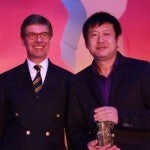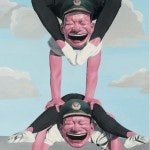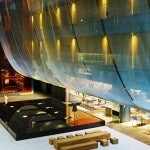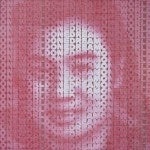Our 10 Favorite Arts And Auction Posts Of The Year#

2010 “Art Power” Awards Ceremony Held In Beijing: Zhou Chunya Tops, Ai Weiwei Outside (February 23)
This week, BMW and Art Value Magazine (艺术财经) held the fourth annual “Chinese Contemporary Art Power” awards ceremony in Beijing’s 798 arts district, celebrating the work of some of China’s top artists, curators, galleries and arts institutions. Reflecting on the year in Chinese contemporary art, the key word during the event was “upward,” as the year marked a turnaround from the comparatively dour mood that prevailed in the wake of the global financial crisis in 2009. With 2010 being the year that blue-chip Chinese contemporary artists once again gained global recognition and new Chinese collectors drove Chinese art towards a “second boom,” this week’s “Art Power” awards had a lot of ground to cover.
In all, a jury of 100 artists, curators, and art critics voted on 18 awards to artists and arts organizations, celebrating “their efforts to impact the world of of Chinese contemporary art, to promote the Chinese contemporary art market and make a contribution to academic development, and to break through industry limitations.”

Trend Watch: Inflation Fueling Chinese Art Market (March 10)
With the Sotheby’s spring auctions set to kick off in just a few weeks, with the highly anticipated sale of 106 works from the Ullens Collection and the Asian Contemporary Art auction on April 4, speculation is brewing on how large a presence mainland Chinese collectors will have, and how far above high estimates they’ll push prices. As Jing Daily wrote earlier this week, we expect to see the “repatriation” effect playing a larger role in buying habits next month than it did in 2010, since Chinese media reports that many Western collectors have been priced out of the market over the past two years, and more Chinese collectors are looking to keep Chinese contemporary art within China, a trend we have previously only seen in the traditional art and antique markets.
However, patriotism only takes Chinese buyers so far. Many, in not most, collectors are looking for a stable investment as well, and that’s where the Chinese buying predilection towards long-term value and stability kicks in.

Records Swept Away At Sotheby’s Chinese Contemporary Art Auctions In Hong Kong (April 4)
Sotheby’s Hong Kong saw a spending frenzy this weekend at its spring auctions, with the auction of more than 100 lots from the collection of Chinese contemporary art “early adopter” Baron Guy Ullens starting the bidding for Chinese art off with a bang. While Chinese collectors had been expected to drive prices for lots by top artists well beyond high estimates, they seemed to outdo even themselves, with their aggressive bidding driving prices for certain pieces up to new highs, even breaking the record for a single piece of Chinese contemporary art set in 2008 by Zeng Fanzhi’s “Mask Series 1996 No. 6.” In all, the Ullens auction took in a whopping US$54.9 million, well over the pre-sale estimate of $16.7 million, with $10.1 million of that coming from the sale of Zhang Xiaogang’s “Forever Lasting Love,” the 1988 triptych that most observers (rightly) expected to steal the show.
With the Chinese contemporary art market currently seeing the signs of a “second boom,” driven this time by demand from Chinese — rather than the formerly dominant Western — collectors, some expect that the amount spent for Zhang’s triptych could become something of a baseline.

Boutique Hotels “Gotta Have Art” To Stand Out In China Market (April 19)
The Opposite House, operated by Hong Kong hotel powerhouse Swire, is at once similar and quite different than Yi House and Langham Place, with an expertly curated mix of Chinese contemporary artists that is geared more towards complementing the hotel, rather than acting as its single defining feature. Designed by Japanese architect Kengo Kuma (who more recently created the interior of Shang Xia’s inaugural boutique in Shanghai), the Opposite House is arguably the most active and engaged of China’s art hotels, and regularly hosts exhibitions loaned by local galleries like F2 and Red Gate, as well as solo exhibitions by local artists and independent film showings. As Philip Tinari, editor-in-chief of the Chinese art magazine Leap, told the Global Times this week, “Turning the central space over to different galleries has made for an interesting succession of installations; my only regret is that these often clash with the actually very nice ‘permanent’ art on display in the lobby.”
As Tinari added, Yi House may have more direct competition from the Opposite House sooner than it might like: “Swire Hotels, the Opposite House parent company, has been particularly smart about playing the art card, a trend that will expand with the opening of a new location near 798.”

Top Chinese Artists Come Together For “Love And Hope” Japan Charity Event (May 10)
Last night, some of China’s top “blue-chip” artists and photographers came together in Beijing at a charity event to provide relief to children affected by the recent earthquake and tsunami in Japan. The “Love and Hope” event, jointly organized by the married founders of Beijing’s respected Three Shadows Photography Art Centre — Rong Rong and Inri (who is, herself, Japanese) – and painter Huang Rui, saw some of China’s top contemporary artists, as well as some from Japan and South Korea, donate works to a charity sale and come together amid a tighter creative environment in the Chinese capital.
As Artinfo points out, some of China’s greatest living contemporary artists contributed works to the charity sale, with some very influential figures in the Chinese art scene further lending their support.

Arts Education In Hong Kong Growing To Meet Mainland Chinese Demand (July 12)
As Jing Daily wrote in April, the ever-increasing number of new Chinese collectors looking to get involved in the art auction market has led to growing demand for arts education, particularly in Hong Kong. Over the past few years, in addition to more local organizations offering educational courses in Chinese art, art appreciation and art collecting, the academic wings of international auction houses like Sotheby’s and Christie’s have started to offer short courses in Hong Kong aimed squarely at mainland Chinese. In May, just in time for its spring auction series in Hong Kong, Christie’s rolled out a three-day short course, “Introduction to the Modern and Contemporary Chinese Art Market”, which was offered for the first time in Mandarin.
This month, another course designed to cater to art lovers and aspiring collectors from mainland China and elsewhere has made its debut in Hong Kong, at the city’s landmark Peninsula Hotel.

Will Art Financing Make Its Way To China’s New Collectors? (July 25)
Driven by inflation fears, the appreciation of the Chinese yuan, a volatile property market, few outside investment options and a desire for the signifiers of sophistication, the strong buying of China’s new generation of art, wine and antique collectors is proving a critical factor in the resurgence of Chinese contemporary art, traditional ink paintings, and even vintage bottles of baijiu. However, not all of China’s aspiring new collectors can afford to drop millions at auction on a Zeng Fanzhi painting, and in response to growing demand we’ve seen new art funds, and pilot programs like Tianjin’s art “stock market,” offer investors of more modest means a chance to get involved in the art world.
So as China’s new collector class matures, along with the Chinese art market as a whole, what other investment options could we see emerging?

Super-Collector Wang Wei’s Dragon Art Museum Hits Construction Milestone (August 2)
This past February, Jing Daily covered Chinese art “super-collector” Wang Wei’s long-discussed private art museum in Shanghai, which Wang and billionaire investor husband Liu Yiqian plan to open next year. The “Dragon Art Museum” (龙美术馆) will showcase Wang and Liu’s extensive collection of blue-chip Chinese contemporary art on the ground floor, Wang’s Mao-era “Red Classics” from 1949-1979 on the second, and traditional works and ancient artifacts on the third floor.
Taking over a section of the former Tomson Centre (汤臣别墅商业中心) building in Shanghai’s Pudong district, near the Shanghai New International Expo Center, Wang’s museum will expand the original 8,000 square meter space to 12,000 square meters.

François Pinault’s Obsession With Zeng Fanzhi, Luxury And Chinese Contemporary Art (September 26)
Pinault’s holding company Artemis counts the Château-Latour vineyard in Bordeaux, the news magazine Le Point and the daily newspaper l’Agefi among the prizes in its portfolio. Having handed control to PPR to his son, François-Henri Pinault, in 2003, the elder Pinault currently holds the title of honorary president.
Perhaps most important to Pinault in terms of his passions, though, is the auction house Christie’s, a controlling percentage of which he purchased in 1998. In addition to being one of the most high-profile figures in the luxury industry, Pinault is one of the world’s largest collectors of contemporary art. In May 2005, Pinault acquired the prestigious Palazzo Grassi in Venice, where he presented a portion of his collection over the course of three exhibitions: “Where Are We Going?”, “Post-Pop,” and “Sequence 1.” In addition to holding a vast collection of works by top Western artists like Andy Warhol, Mark Rothko, Jeff Koons, Cindy Sherman and Gerhard Richter, Pinault — like many of the brands owned by PPR — has a growing love affair with China.

The Earning Power of Art
(December 12)
Much to my surprise, I continue to hear a lot of talk about art funds and art stocks and their success at attracting investors, especially, here, in China. We even recently wrote a commentary about art funds, brushing off the very idea for anyone serious about investing in art. In the meantime, we keep hearing about more people jumping into the fray. In China, more and more people seem to be getting into the auction business, which has its shady side, and opening art stock funds and exchanges, too. And while sitting through a boring slideshow about why art can make money, I had a change of heart about the usefulness of these new art investment vehicles.
So, let us step back, first, to look at the basics of finance.
